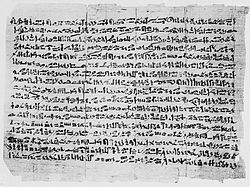Hearst papyrus
The Hearst papyrus is an ancient Egyptian medical papyrus . It contains many parallels to the Ebers papyrus , but also recipes for new, partly unknown diseases such as B. the " Asians disease " ( leprosy or bubonic plague ).
Research history
The papyrus was discovered in the spring of 1901 by a local in the remains of the settlement near Deir el-Ballas , where an expedition led by George Andrew Reisner was working. The papyrus was named in honor of Phoebe Hearst , mother of William Randolph Hearst , who financed the expedition. The hieratic text was published by Reisner in 1905. In 1912 Walter Wreszinski published a hieroglyphic transcription and a translation into German. The last and most detailed treatment was done in the middle of the 20th century by Hildegard von Deines, Hermann Grapow and Wolfhart Westendorf .
Today the Hearst Papyrus is in the Bancroft Library at the University of California, Berkeley .
description
The papyrus consists of a roll with a length of 3.5 m written on one side. The text is divided into eighteen columns, the last three of which have been partially destroyed. The dating ranges from the beginning of the New Kingdom (around 1550 BC) to the reign of Thutmose III.
content
Like the Ebers papyrus, the Hearst papyrus is a composite manuscript. It comprises 260 unstructured individual texts, more than a third of which have parallels to Ebers. These include a. Recipes for vascular treatment, general treatment of pain ( wechedu ), wound healing and the fight against demonic diseases, but no teaching texts .
The cases that are missing from the Ebers Papyrus are particularly interesting. These include broken bones and the Asian disease that may have been identified as leprosy. However, there are also spells that were recited when measuring and using frequently used drugs .
In the treatment of bite wounds, the Hearst papyrus supplements the boar with bites from the pig , the hippopotamus and the lion . When it comes to the treatment of fingers and toes, the Ebers group is even exceeded by the Hearst group (33 cases in the Hearst papyrus compared to nine in the Ebers papyrus).
See also
literature
- Hildegard von Deines, Hermann Grapow , Wolfhart Westendorf : Outline of the medicine of the ancient Egyptians. (Transcription, translation, commentary, dictionary, grammar). Akademie-Verlag, Berlin 1954–1973.
- Manuela Gander: The medical papyri - an overview. In: Kemet. Volume 14, Issue 2: Medicine and Magic. 2005, ISSN 0943-5972 , pp. 41-46, here p. 43.
- Chauncey D. Leake : The Old Egyptian Medical Papyri (= Logan Clendening Lectures on the History and Philosophy of Medicine. Vol. 2, ISSN 0459-6897 ). University of Kansas Press, Lawrence KS 1952.
- John F. Nunn: Ancient Egyptian Medicine. The British Museum Press, London 1996, ISBN 0-7141-1906-7 , 35.
- George A. Reisner: The Hearst Medical Papyrus. Hieratic Text (= University of California Publications in Egyptian Archeology. Vol. 1, ZDB -ID 445580-0 ). In 17 Fascimile Plates in Collotype with Introduction and Vocabulary. Hinrichs, Leipzig 1905.
- Wolfhart Westendorf: Handbook of Ancient Egyptian Medicine (= Handbook of Oriental Studies . = Handbook of Oriental Studies. Division 1: The Near and Middle East (= . The Near and Middle East . Volume 36, Part 1) Brill, Leiden / Boston / Cologne 1999, ISBN 90-04-11320-7 , pp. 35-37.
- Walter Wreszinski : The medicine of the ancient Egyptians. Volume 2: The London Medical Papyrus (Brit. Museum No. 10059) and the Hearst Papyrus. Transcription, translation and commentary. Hinrichs, Leipzig 1912.
References and comments
- ^ A b Nunn: Ancient Egyptian Medicine. 1996, p. 35.
- ↑ Deines, Grapow, Westendorf: Outline of the medicine of the ancient Egyptians .
- ^ Bancroft Library website .
- ^ A b Westendorf: Handbook of ancient Egyptian medicine. 1999, pp. 35-37.
Web links
- Hearst papyrus in the Bancroft Library (English)
- Publication by George A. Reisner, 1905 (Digital Library Munich, English)
- Entry in the Tebtunis papyri database on the Hearst papyrus (P.Hearst.0001, APIS ID 4970) plus photo of column 8, recto + verso (Bancroft Library, University of California, English)
